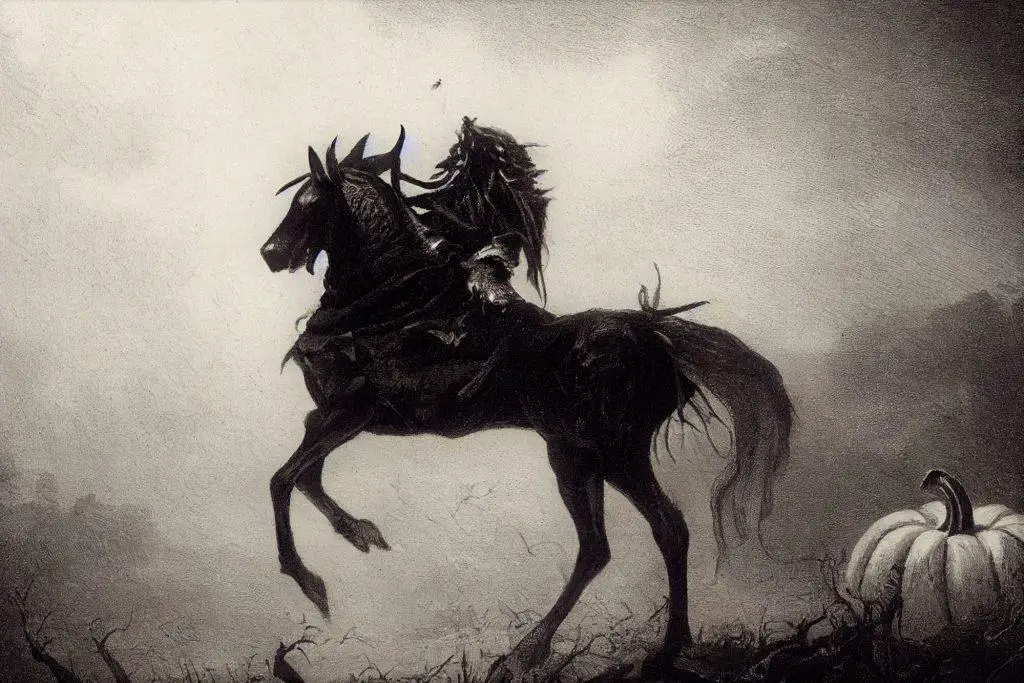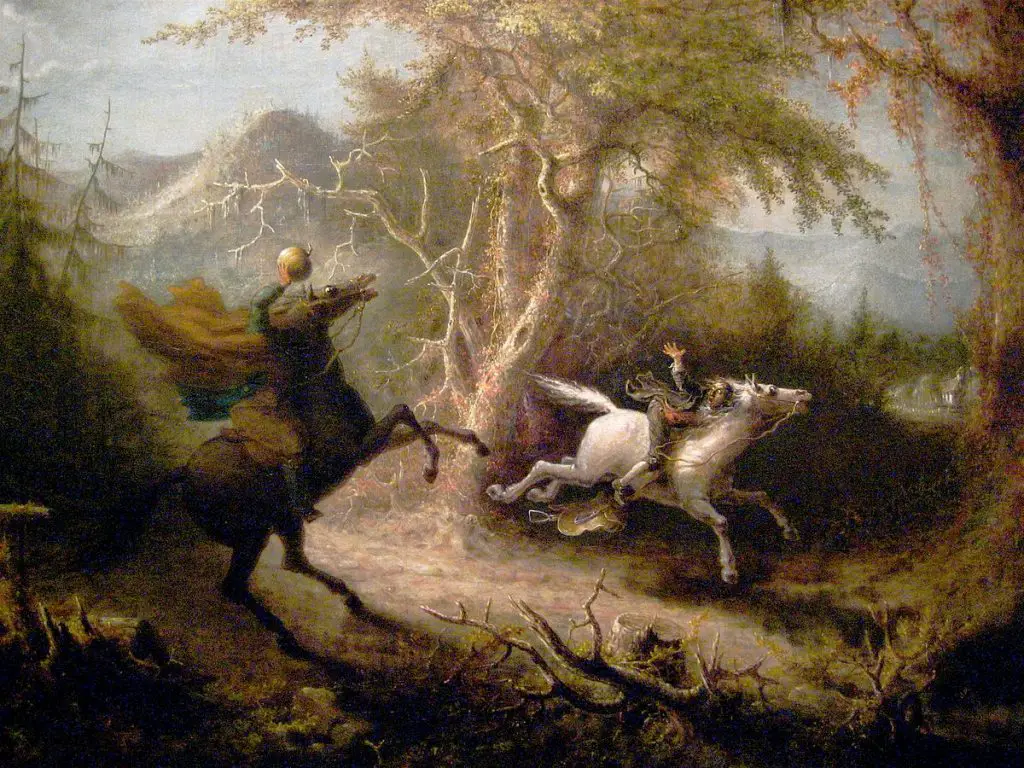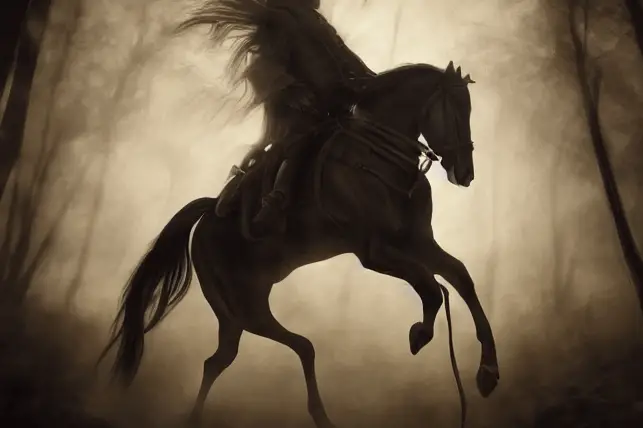Share the Lore!
By: Alex Postrado
From Celtic Mythology to American Ghost Story
It has been over 200 years since the headless creature of Washington Irving’s Gothic tale, The Legend of Sleepy Hollow, first roamed our literary history.
But, did you know that it wasn’t Irving, who coined the idea of a headless, horse-riding ghost, roving around at night?
Despite it being one of America’s oldest ghost stories, Medieval Europe was actually 一 and ironically 一 the cradle of the lore of The Headless Horseman.
And now, it continues to follow us in the form of modern-day sighting stories, as well as pop culture references.
From supposed Halloween encounters to Tim Burton’s 1999 film Sleepy Hollow, here’s a walk through the tale of the dreaded Horseman.
Meet The Headless Rider of Sleepy Hollow
“A horseman of large dimensions”, “mounted on a black horse of powerful frame”, “gigantic in height”, “muffled in a cloak”, and “headless!”
That was how The Legend of Sleepy Hollow described the Headless Horseman.
The figure that, when seen in the dead of night, would send anyone running desperately for their lives!
Washington Irving’s 1820 masterpiece 一 The Legend of Sleepy Hollow 一 was the first to introduce the Headless Horseman to the land of America.

Set in the year 1790, in a secluded and mystery-shrouded glen, known as Sleepy Hollow, it follows the story of Ichabod Crane and his failed shot at winning the hand of the wealthy heiress, Katrina Van Tassel.
Now, it might seem like your typical romantic tale from the olden days, but don’t be fooled!
There’s an unexpected turn in Irving’s story: the fair share of supernatural phenomena in the village of Sleepy Hollow.
One of which involves the iconic Headless Horseman.
According to the town’s legend, the Headless Horseman 一 also called the Galloping Hessian 一 was the vengeful ghost of a mercenary who was decapitated by cannon fire during the Revolutionary War.
One eerily-quiet night, Ichabod encounters the headless rider. And the next day 一 he goes missing!
This was the narrative that widely popularized the Headless Horseman, especially in 1800s America.
But, believe it or not, if we were to trace the roots of the Headless Horseman, history would take us back as far as the Middle Ages.
Have you ever heard of the Dullahan?
The Origin of The Headless Horseman
Even before The Legend of Sleepy Hollow was published, mentions of a headless rider already traveled across Europe.
But, the Dullahan 一 a mythological entity in Irish folklore 一 was probably what inspired Irving’s legendary Horseman.
How? You may ask.
Well, while Washington Irving was American, his parents were immigrants with English and Scottish heritage.
He frequently took trips all over Europe, including Ireland.
And he was friends with Sir Walter Scott, a renowned Scottish historical novelist.
Any of these could explain how the legend of the Dullahan was introduced to him.
First appearing in collections of Irish tales 一 such as the book, Fairy and Folk Tales of the Irish Peasantry by W. B. Yeats, as well as Thomas Crofton Croker’s Fairy Legends and Traditions of the South of Ireland 一 the Dullahan was known to be the embodiment of the malevolent Celtic god, Crom Dubh, and the original Headless Horseman.
But, accounts illustrating the appearance of the Dullahan vary widely.
Some say that the Dullahan is a decapitated rider, carrying his own head on one hand and a whip of human spine on the other.
In contrast, others say that it is a cursed ghost, simply in search of its head. Some claim it is Crom Dubh, himself, demanding blood sacrifice through decapitation.
While others argue that the Dullahan isn’t inherently male and could sometimes be female.
However, among all interpretations of the original Headless Horseman, what’s perhaps most interesting is the claim that the horse 一 or sometimes, horses 一 that the Dullahan rides is also headless.
And there’s actually a pretty grim reason behind this.
The Symbolism Behind The Lore
According to the lore, the Headless Horseman doesn’t always show up to take lives.
Rather, its manifestation could sometimes be a forewarning that something grave would happen.
And that should come as no surprise.
After all, the Headless Horseman was heavily influenced by stories of saints, martyred by beheading.
You see, Ireland has been Catholic since the 5th Century.
And throughout history, there has been a total of 120 accounts of decapitated, head-carrying saints 一 told and portrayed through different works of art and literature.
Similarly, ancient Celts 一 way before Catholicism was prevalent in Europe 一 also beheaded their enemies in an effort to dehumanize them.
The Celts believed that the head contains the soul, so “removing the head damages the spirit”.
Given all this, wrapping your head around the connection of tragedy to the Headless Horseman probably wouldn’t be as hard as it first seemed.
But if that explains the decapitated rider, how about the headless horses?
Well, in Medieval Ireland, one of the greatest ways to dishonor a dead person was to bury his body with a decapitated animal.
A lot of evidence, documentation, and studies on this could be found all over the internet, but this double burial clearly had a hand in creating the image of the Headless Horseman.
And with this, it’s hard to ignore the reality behind the long-lived lore.

Painting by John Quidor
The Truth to the Headless Horseman
The legendary Horseman has been featured in plenty of works from both the distant past and modern pop culture.
It may be easy to pass it off as a pure work of fiction. But the truth is: it’s so much more than that.
From the horse-riding ghost of Irish folklore to the head-carrying martyrs of the Dark Ages 一 the Headless Horseman has always been lurking in the twilight zone.
A rare combination of fact and fiction 一 fading the line between what’s real and what’s not.
If you don’t know, Sleepy Hollow is a place that exists.
But the Horseman most likely didn’t.
It is a product of history, religion, and literature 一 merged to create a being that would travel across continents.
Forever giving mankind a figurative “heads up” about the horror that is waiting to happen.
References:
'The Legend of Sleepy Hollow' is 'America's first ghost story' The Legend of Sleepy Hollow The Legend of the Headless Horseman Explained How tales of the headless horseman came from Celtic mythology The Dullahan and Its Headless Horses The Decapitated Saints Who Still Managed to Hold Their Heads Up Osteological Evidence for Decapitation in Medieval Ireland
